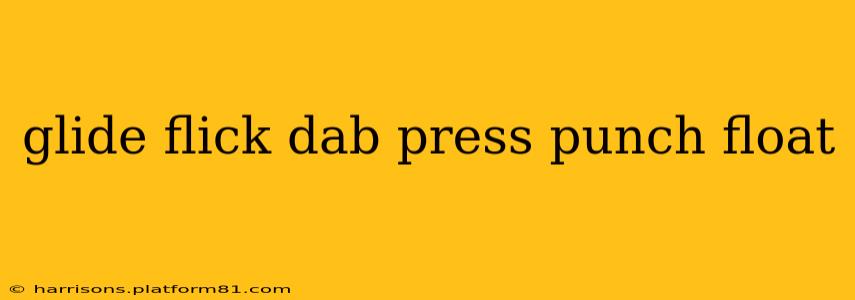Whether you're a seasoned dancer, a martial artist, or simply someone interested in improving body control and movement fluidity, understanding and mastering techniques like glide, flick, dab, press, punch, and float can significantly enhance your performance and artistry. These movements, often used in various dance styles and martial arts, require precision, control, and a deep understanding of body mechanics. This comprehensive guide explores each technique individually, offering insights into their execution and applications.
What is a Glide?
A glide is a smooth, continuous movement across a surface, often characterized by a controlled, low-to-the-ground flow. Think of a skater effortlessly gliding across ice or a dancer smoothly transitioning between poses. The key to a successful glide is maintaining a relaxed yet controlled posture, allowing your body weight to distribute evenly and minimizing friction.
How to Execute a Glide:
- Relaxation: Avoid tension in your muscles. A relaxed body allows for smoother movement.
- Weight Distribution: Distribute your weight evenly across your supporting surface.
- Controlled Movement: Avoid jerky movements. Maintain a consistent pace and fluidity.
- Body Alignment: Maintain good posture to ensure efficient movement and prevent injury.
Understanding the Flick: A Quick, Precise Movement
A flick is a rapid, sharp movement, often used to create emphasis or punctuate a sequence. Unlike a glide, a flick is characterized by its suddenness and precision. It’s a powerful tool for adding dynamism and expressiveness to your performance.
Mastering the Flick:
- Speed and Precision: The flick relies on speed and accuracy. Practice controlling the speed and range of motion.
- Muscle Isolation: Focus on isolating the muscles involved in the flick to enhance control.
- Controlled Release: Allow for a controlled release of the movement to avoid jerky or uncontrolled movements.
- Context is Key: The effectiveness of a flick depends on its placement within the larger movement sequence.
The Dab: A Subtle Yet Powerful Gesture
The dab, often seen in contemporary dance and hip-hop styles, is a subtle yet expressive gesture. It typically involves a quick, controlled touch or tap, often using the fingertips or the side of the hand. It can be used to add a playful element or to create a sense of intimacy.
Executing a Clean Dab:
- Precision and Control: The dab's impact lies in its controlled precision. Practice achieving consistent, sharp movements.
- Body Positioning: Pay attention to your overall body positioning to accentuate the dab's impact.
- Timing and Rhythm: The timing and rhythm of the dab are crucial to its effectiveness. Experiment with different tempos.
- Style and Interpretation: Allow your personality and style to shine through when executing a dab.
What is a Press in Movement?
A press, in the context of movement, involves a controlled application of force or pressure. This could be a downward press (e.g., pressing into the floor for a powerful leap), a lateral press (e.g., pressing against a partner), or even a subtle press used for creating tension and release.
Mastering the Press:
- Controlled Force: Practice controlling the amount of force applied. Avoid excessive pressure to prevent injury.
- Engagement and Release: Learn to effectively engage and release the muscles involved in the press.
- Body Alignment: Maintain proper body alignment to ensure efficient and injury-free execution.
- Application: Experiment with different directions and intensities of press movements.
The Punch: Power and Precision Combined
A punch, often associated with martial arts, involves a swift, powerful extension of the arm or leg. In dance and movement, a punch can be stylized to emphasize a particular moment or enhance the overall dynamic of the piece. However, proper technique is crucial to prevent injury.
Executing a Safe and Effective Punch:
- Proper Technique: Learn correct punching technique from a qualified instructor, focusing on proper form and power generation.
- Controlled Power: Control the force of the punch to avoid injury to yourself and others.
- Full Body Involvement: Engage your entire body, not just your arm, for maximum power and control.
- Follow Through: Maintain a controlled follow-through motion after the punch.
Understanding the Float: Effortless Movement and Grace
A float implies a sense of lightness and effortlessness. This movement is often characterized by a smooth, seemingly weightless quality, allowing for a sense of ethereal grace and fluidity. It often requires a combination of balance, control, and coordination.
Achieving a Float:
- Balance and Coordination: This movement requires exceptional balance and coordination.
- Muscle Control: Maintaining a controlled and balanced posture is essential to achieve the appearance of floating.
- Smooth Transitions: Transitions between positions should be seamless and graceful.
- Visual Impact: The objective is to create the illusion of weightlessness, thereby enhancing the artistic effect.
By understanding and practicing these six fundamental movements – glide, flick, dab, press, punch, and float – you can significantly improve your overall movement quality, expressiveness, and artistry, regardless of your chosen style or discipline. Remember to practice safely and consult with professionals for guidance and feedback.
